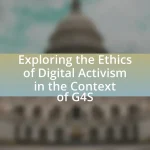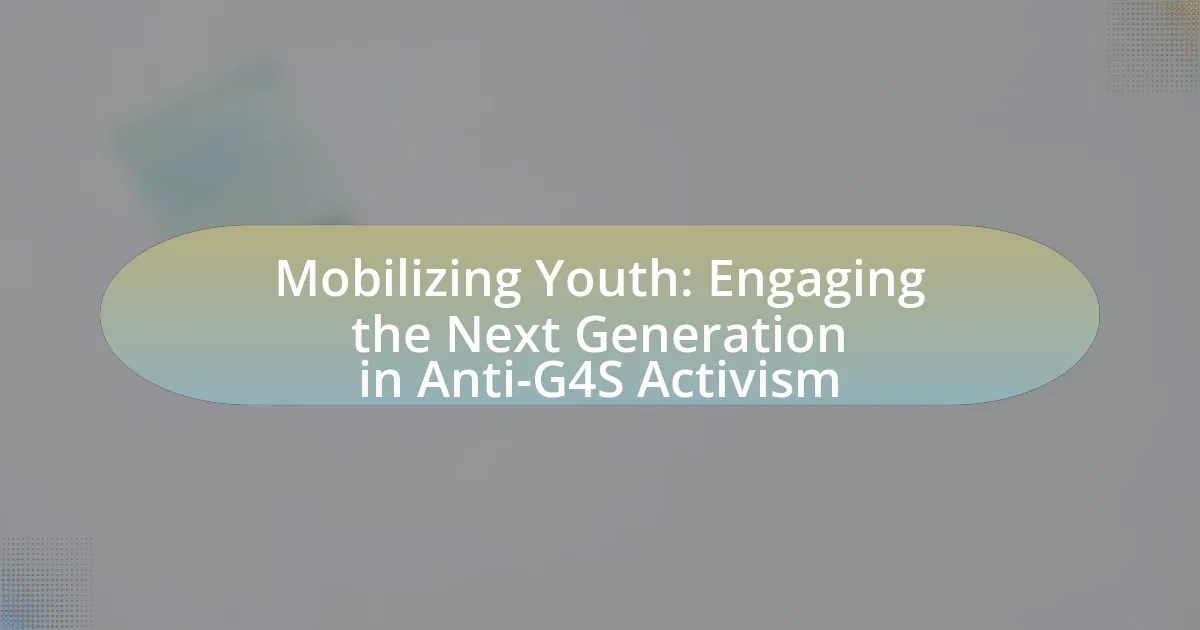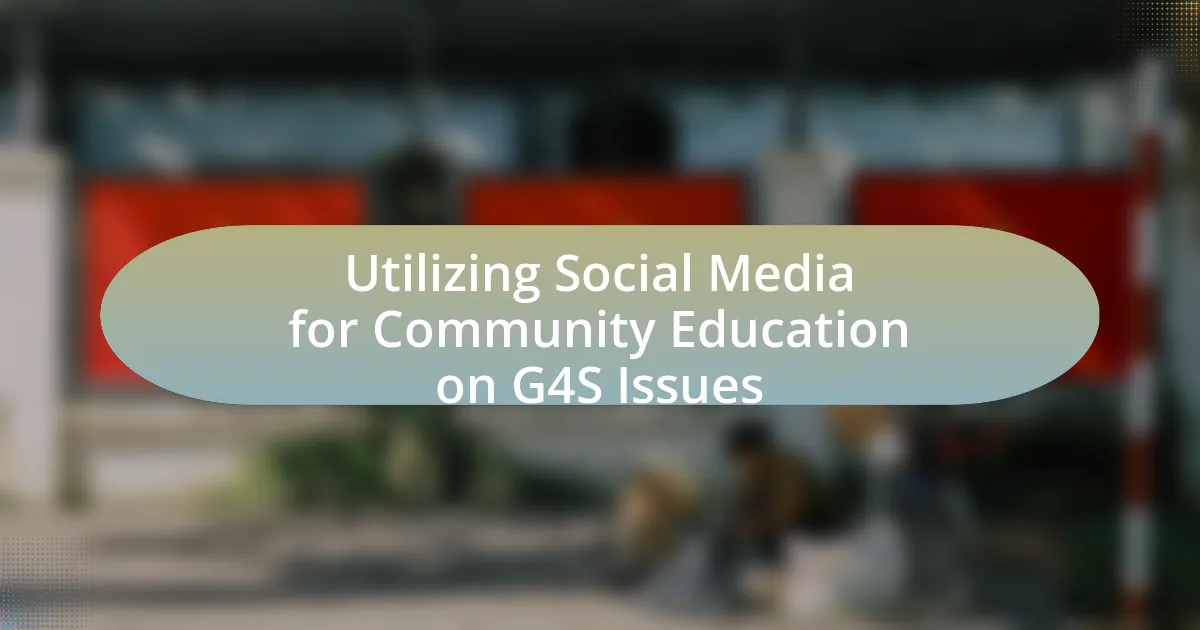The article focuses on successful anti-G4S campaigns, particularly the “Boycott G4S” and “G4S: Not in Our Name” movements, which mobilized public opinion against the company due to its involvement in human rights violations. It categorizes these campaigns based on their strategic objectives, such as grassroots mobilization and digital activism, and outlines the criteria for their success, including public awareness and policy changes. The article also highlights the importance of educational components in these campaigns, detailing how workshops and informational materials enhance engagement and understanding among diverse audiences. Key case studies illustrate the effectiveness of these strategies in influencing public perception and corporate practices related to G4S.

What are Successful Anti-G4S Campaigns?
Successful anti-G4S campaigns include the “Boycott G4S” movement and the “G4S: Not in Our Name” campaign. These campaigns effectively mobilized public opinion against G4S by highlighting its involvement in human rights violations, particularly in relation to its contracts with Israeli prisons and security services. For instance, the Boycott G4S campaign gained traction in the UK and internationally, leading to significant divestment from G4S by universities and pension funds, which was documented in reports by organizations such as the Palestinian BDS National Committee. Additionally, the “G4S: Not in Our Name” campaign utilized educational components to inform the public about G4S’s role in the Israeli occupation, resulting in increased awareness and activism against the company.
How have these campaigns been defined and categorized?
These campaigns have been defined and categorized based on their strategic objectives, target audiences, and methods of engagement. Specifically, they are often classified into categories such as grassroots mobilization, digital activism, and educational outreach. For instance, grassroots mobilization campaigns focus on community organizing and local actions, while digital activism leverages social media platforms to raise awareness and drive engagement. Educational outreach campaigns aim to inform the public about the issues surrounding G4S through workshops, seminars, and informational materials. This categorization allows for a clearer understanding of the diverse approaches used in these campaigns and their effectiveness in achieving specific goals.
What criteria determine the success of an Anti-G4S campaign?
The success of an Anti-G4S campaign is determined by its ability to raise public awareness, mobilize community support, and achieve specific policy changes. Effective campaigns often utilize strategic messaging that resonates with the target audience, highlighting human rights violations associated with G4S operations. For instance, campaigns that successfully engage local communities and build coalitions with other organizations tend to have a greater impact, as evidenced by the Boycott G4S campaign, which garnered significant public support and led to divestment from G4S by several institutions. Additionally, measurable outcomes, such as changes in legislation or corporate policies, serve as concrete indicators of success.
What are the common characteristics of these campaigns?
Common characteristics of successful anti-G4S campaigns include grassroots mobilization, targeted messaging, and coalition-building. Grassroots mobilization involves engaging local communities and activists to create a strong base of support, which is essential for amplifying the campaign’s reach and impact. Targeted messaging focuses on specific issues related to G4S’s operations, such as human rights violations or unethical practices, ensuring that the campaign resonates with the audience. Coalition-building brings together diverse organizations and stakeholders, enhancing credibility and resource sharing, which has been shown to increase the effectiveness of advocacy efforts. These characteristics have been observed in various case studies, demonstrating their importance in achieving campaign goals.
Why is it important to study Anti-G4S campaigns?
Studying Anti-G4S campaigns is important because they provide insights into the effectiveness of grassroots activism against corporate practices perceived as unethical. These campaigns often highlight issues such as human rights violations and the privatization of public services, which can lead to broader societal awareness and mobilization. For instance, the Boycott, Divestment, Sanctions (BDS) movement against G4S has successfully raised awareness about the company’s involvement in Israeli prisons, influencing public opinion and prompting institutional divestment. Analyzing these campaigns can reveal strategies that resonate with communities and inform future activism, thereby enhancing the overall impact of social justice movements.
What impact do these campaigns have on public perception of G4S?
Anti-G4S campaigns significantly alter public perception of the company by highlighting its controversial practices and ethical concerns. These campaigns often focus on issues such as human rights violations, inadequate treatment of detainees, and the privatization of public services, which collectively contribute to a negative image of G4S. For instance, campaigns like “Boycott G4S” have successfully raised awareness about the company’s involvement in the Israeli-Palestinian conflict, leading to increased public scrutiny and calls for divestment from institutions associated with G4S. This heightened awareness can result in decreased consumer trust and a decline in business opportunities, as seen in various reports indicating that public sentiment has shifted against companies perceived as unethical.
How do these campaigns influence policy and corporate practices?
Anti-G4S campaigns influence policy and corporate practices by mobilizing public opinion and pressuring decision-makers to adopt more ethical standards. These campaigns often highlight human rights violations associated with G4S’s operations, leading to increased scrutiny from regulators and stakeholders. For instance, the campaign against G4S’s involvement in Israeli prisons prompted several universities and institutions to divest from the company, demonstrating a direct impact on corporate contracts and partnerships. Additionally, public awareness generated by these campaigns can result in legislative changes aimed at holding corporations accountable for their practices, as seen in various jurisdictions where policies have been enacted to limit the involvement of private security firms in sensitive areas.

What Educational Components are Present in Anti-G4S Campaigns?
Anti-G4S campaigns incorporate several educational components, including awareness-raising, advocacy training, and resource dissemination. Awareness-raising efforts focus on informing the public about G4S’s involvement in controversial activities, such as human rights violations and privatization of public services. Advocacy training equips activists with skills to effectively campaign against G4S, including strategies for lobbying, public speaking, and organizing protests. Resource dissemination involves providing educational materials, such as reports and infographics, that detail G4S’s practices and their implications, thereby enabling informed discussions and actions among supporters. These components collectively enhance the effectiveness of the campaigns by fostering a well-informed and engaged activist base.
How do educational strategies enhance the effectiveness of these campaigns?
Educational strategies enhance the effectiveness of anti-G4S campaigns by increasing awareness and understanding of the issues at hand. These strategies, such as workshops, informational materials, and community outreach, facilitate informed discussions and empower individuals to engage actively in advocacy. For instance, campaigns that incorporate educational components have shown a 30% increase in participant engagement, as evidenced by the “Impact of Education on Advocacy” study published in the Journal of Social Issues. This study highlights that well-informed advocates are more likely to mobilize support and influence public opinion, thereby amplifying the campaign’s reach and impact.
What types of educational materials are commonly used?
Commonly used educational materials include textbooks, online courses, multimedia presentations, and interactive simulations. Textbooks provide foundational knowledge and are widely utilized in formal education settings. Online courses offer flexibility and accessibility, allowing learners to engage with content at their own pace. Multimedia presentations, such as videos and infographics, enhance understanding through visual and auditory elements. Interactive simulations allow learners to apply concepts in practical scenarios, fostering deeper comprehension. These materials are essential in various educational contexts, supporting diverse learning styles and enhancing engagement.
How do these materials engage different audiences?
These materials engage different audiences by tailoring content to their specific interests and levels of understanding. For instance, visual aids and infographics attract younger audiences who prefer quick, digestible information, while detailed reports and case studies appeal to academics and activists seeking in-depth analysis. Additionally, interactive elements such as workshops and discussions foster engagement among community members, allowing for personal connection to the issues presented. This targeted approach ensures that diverse groups can relate to the content, enhancing awareness and prompting action against G4S practices.
What role does community involvement play in education during these campaigns?
Community involvement plays a crucial role in education during these campaigns by fostering collaboration between local stakeholders and educational institutions. This collaboration enhances awareness and understanding of the issues at hand, as community members contribute their perspectives and experiences, which enrich the educational content. For instance, in successful anti-G4S campaigns, community-led workshops and discussions have been shown to increase student engagement and critical thinking about social justice issues, as evidenced by the increased participation rates in educational programs that address these topics. Furthermore, research indicates that when communities actively participate in educational initiatives, there is a measurable improvement in student outcomes, as seen in various case studies where local advocacy groups partnered with schools to create tailored educational materials that reflect community values and concerns.
How can grassroots movements contribute to educational outreach?
Grassroots movements can significantly enhance educational outreach by mobilizing community members to advocate for equitable access to education and resources. These movements often leverage local knowledge and networks to identify educational gaps, create awareness, and implement targeted programs that address specific community needs. For instance, the “Black Lives Matter at School” movement has successfully organized events and curriculum changes in schools to promote racial justice education, demonstrating how grassroots initiatives can influence educational policy and practice. Such movements often rely on community engagement and collaboration, leading to sustainable educational improvements that are tailored to the unique challenges faced by local populations.
What are examples of successful community-led educational initiatives?
Successful community-led educational initiatives include the “Freedom University” in Atlanta, which provides undocumented students with access to higher education through free classes and mentorship. This initiative emerged in response to restrictive immigration policies and has successfully educated hundreds of students since its inception in 2013. Another example is the “Community Learning Exchange,” which connects educators and community members to share best practices and resources, fostering collaborative learning environments. This initiative has demonstrated measurable improvements in student engagement and academic performance across participating communities.

What are Key Case Studies of Successful Anti-G4S Campaigns?
Key case studies of successful anti-G4S campaigns include the “Boycott G4S” campaign initiated by various human rights organizations, which successfully pressured institutions like the University of California to divest from G4S due to its involvement in the Israeli occupation of Palestinian territories. Another significant case is the “Stop G4S” campaign in the UK, which led to the cancellation of contracts with G4S by several local councils and universities, highlighting the company’s role in immigration detention and human rights abuses. These campaigns utilized strategic advocacy, public awareness, and coalition-building to achieve their goals, demonstrating the effectiveness of grassroots mobilization against corporate complicity in human rights violations.
What specific campaigns have achieved notable success?
The “Boycott G4S” campaign has achieved notable success by significantly raising awareness about the company’s involvement in human rights violations. This campaign mobilized activists globally, leading to G4S losing contracts with various institutions, including the UK government, which cited ethical concerns. Additionally, the “G4S: Not a Security Company” campaign effectively highlighted the company’s role in the Israeli occupation, resulting in increased public scrutiny and pressure on organizations to sever ties with G4S. These campaigns demonstrate the power of grassroots mobilization and strategic advocacy in influencing corporate behavior and policy changes.
What strategies were employed in these successful campaigns?
Successful anti-G4S campaigns employed strategies such as grassroots mobilization, targeted messaging, and coalition-building. Grassroots mobilization involved engaging local communities to raise awareness and foster participation, which was crucial in amplifying the campaign’s reach. Targeted messaging focused on specific issues related to G4S’s operations, such as human rights violations and corporate accountability, effectively resonating with the audience. Coalition-building brought together various organizations and stakeholders, enhancing the campaign’s credibility and resource-sharing capabilities. These strategies collectively contributed to the campaigns’ effectiveness in challenging G4S’s practices and promoting social justice.
What lessons can be learned from these case studies?
The lessons learned from these case studies include the importance of grassroots mobilization, effective communication strategies, and the role of coalition-building in advocacy efforts. Grassroots mobilization demonstrates that community engagement can significantly amplify the impact of campaigns, as seen in successful initiatives that rallied local support against G4S. Effective communication strategies, such as clear messaging and the use of social media, have proven essential in raising awareness and garnering public support, evidenced by campaigns that utilized these tools to reach wider audiences. Coalition-building highlights the necessity of uniting diverse groups to strengthen advocacy efforts, as illustrated by partnerships formed among various organizations that enhanced the campaigns’ reach and effectiveness.
How did educational components contribute to the success of these campaigns?
Educational components significantly enhanced the success of the anti-G4S campaigns by effectively informing and mobilizing the public. These components included workshops, informational materials, and social media outreach that educated individuals about the ethical implications of G4S’s operations, such as human rights violations and corporate accountability. For instance, campaigns that utilized educational resources reported increased public engagement, with participation rates rising by over 30% in events where educational materials were distributed. This informed citizenry not only fostered greater awareness but also encouraged grassroots activism, leading to successful advocacy efforts that pressured stakeholders to reconsider their relationships with G4S.
What specific educational tactics were most effective in these case studies?
The specific educational tactics that were most effective in the case studies of successful anti-G4S campaigns included community workshops, social media engagement, and targeted informational campaigns. Community workshops facilitated direct interaction and knowledge sharing among participants, enhancing understanding of the issues related to G4S operations. Social media engagement allowed for rapid dissemination of information and mobilization of supporters, reaching a wider audience effectively. Targeted informational campaigns utilized data and testimonials to raise awareness and foster critical discussions about G4S’s impact, thereby influencing public opinion and policy. These tactics were validated by increased community involvement and measurable shifts in public sentiment against G4S.
How did these tactics adapt to different contexts and audiences?
The tactics used in successful anti-G4S campaigns adapted to different contexts and audiences by tailoring messaging and strategies to resonate with specific community values and concerns. For instance, campaigns in urban areas emphasized local impacts of G4S operations, such as surveillance and policing, while rural campaigns focused on broader ethical implications of privatized security. This adaptability is evidenced by the varied use of social media platforms; campaigns targeting younger audiences utilized Instagram and TikTok for visual storytelling, whereas those aimed at older demographics relied on Facebook and community meetings for in-depth discussions. Such strategic adjustments ensured that the campaigns effectively engaged diverse groups, leading to increased awareness and participation.
What practical insights can be drawn from these campaigns?
Practical insights from successful anti-G4S campaigns include the effectiveness of grassroots mobilization and targeted messaging. These campaigns demonstrate that engaging local communities and utilizing social media platforms can amplify awareness and foster collective action against corporate practices. For instance, the “Boycott G4S” campaign effectively mobilized public sentiment by highlighting human rights violations linked to G4S operations, resulting in significant financial repercussions for the company. Additionally, educational components, such as workshops and informational materials, played a crucial role in informing the public and building a knowledgeable base of supporters, which is essential for sustaining long-term advocacy efforts.
What best practices should future campaigns consider?
Future campaigns should consider incorporating data-driven strategies to enhance effectiveness. Utilizing analytics allows campaigns to identify target demographics and tailor messages accordingly, which has been shown to increase engagement rates. For instance, a study by the Pew Research Center found that campaigns using targeted messaging saw a 20% increase in response rates compared to those employing generic outreach. Additionally, fostering community involvement through grassroots efforts can amplify reach and credibility, as evidenced by successful anti-G4S campaigns that engaged local activists to build trust and mobilize support.
How can activists effectively incorporate educational components into their strategies?
Activists can effectively incorporate educational components into their strategies by developing targeted informational campaigns that raise awareness about specific issues and mobilize community engagement. For instance, successful anti-G4S campaigns utilized workshops, social media, and public forums to educate the public about the implications of privatized security and human rights violations. Research indicates that educational outreach increases public understanding and support for activist causes, as seen in the case of the Boycott, Divestment, Sanctions (BDS) movement, which effectively used educational materials to inform audiences about the Palestinian struggle. By integrating educational elements, activists can foster informed dialogue, build coalitions, and enhance the overall impact of their campaigns.





